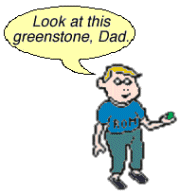 | |||||
| About Us | Contact Us | Services | Copyright | |||||
|
|||||
|
Organizing your Collection By Marilyn Fraser
Once you start a collection of specimens of minerals or rocks, you should organize it into a system. You need to label your specimens and keep a record of them. If you don't know what it is, you can find out later on, but you may forget where you found it and when. The most important thing is to record where you found it – its location – and the date when you found it. Later on, when you have figured out what it is, you can add that to the record. The article Classifying Your Rocks will help you in identifying your specimen. So be sure to put nice neat labels on or with your specimen. One handy way to keep your specimens organized in the beginning is to use paper egg cartons. Put one specimen, with its label, in each egg holder. Each egg carton could be labelled for different classes or minerals:
SortingOnce you get home with the specimens you collected from a field trip, you should lay them all out on a piece of newspaper and inspect them closely. Some will be very poor and should be thrown away. Keep the few very best ones that you found.CleaningOnce you have sorted your specimens, you should clean them. Use cold clear water (do NOT put any soap in it) and an old toothbrush. Some minerals can break very easily so brush them carefully to get all the mud and dirt off them. Sometimes they are stained a bit. With some hard minerals, especially quartz, you can use an efferdent tablet in water and let the specimen sit in a cup for 15-20 minutes. Then brush it in clear cool water. Do not use hot water. Some mineral crystals can be damaged by hot water. As you get more experience we can discuss more about cleaning.Specimen LabelsMake small neat labels about 1.5 inches by 1 inch for the information about your specimen (see Figure 1). If you don't know the name, leave a line to fill that in later. Write in the name of the place where you found it; then the date. It is best to use two or three letters for the month, so there is no confusion about whether you found it on the 9th of May or the 5th of September.

Fig 1. Example of a mineral specimen label.
Cataloguing SpecimensIt would be a good idea to have a small loose-leaf ring-binder style of notebook for cataloguing your specimens. That will help you keep a record and you can move the pages around and add dividers so that the record follows the system you use for storing the minerals.If you have a computer, you can keep a record or catalogue on a disk for your computer. Using a database program is a good way to keep records like this. Tip: For those who want to use a computer, a simple spreadsheet program like Microsoft Excel, Claris Works, or Lotus 1-2-3 can be used to create a catalogue of specimens. These programs are easy to use and more appropriate for beginners and those with smaller collections. Useful BooksA very good small book for beginners is the Golden Guide to Field Identification, Rocks and Minerals. It is published by Golden Press, New York. Its ISBN (that magic ID number) is 0-307-13661-2. It will cost between $15.00 and $20.00. As you get more interested in collecting, there are many more books, a bit more expensive, to help you that are standard books used by collectors.For young real beginners, there is a good small book called The Concise Illustrated Book of Rocks and Minerals by Richard Moody. It is published by Gallery Books of New York and costs about $7.00. The ISBN is 0-8317-1680-0.
This article may not be copied, distributed or reprinted in any form without the author's permission. To contact the author, please use the e-mail address provided. If you are unable to contact the author, please contact the Canadian Rockhound. Authorized reprints must acknowledge the author, original source and the Canadian Rockhound, and include the website URL address of the Canadian Rockhound.
|
|||

Copyright © 2000 Canadian Rockhound
Magazine Issues |
News & Events |
Junior Rockhound |
Resources
|
|||
